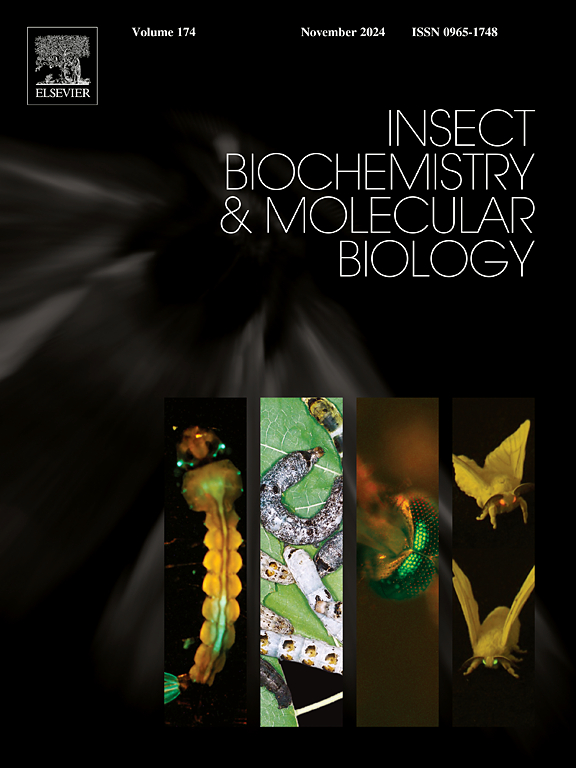斜纹夜蛾对黄素毒素适应过程中ε -谷胱甘肽s -转移酶的功能分析
IF 3.7
2区 农林科学
Q2 BIOCHEMISTRY & MOLECULAR BIOLOGY
引用次数: 0
摘要
通过与寄主植物的长期共同进化,昆虫已经进化出复杂的解毒系统来抵消植物次生代谢物(psm)。然而,这些适应的确切机制仍未完全确定。我们之前的研究发现epsilon谷胱甘肽s -转移酶(GSTes)是斜纹夜蛾(Spodoptera litura)黄毒素适应的关键介质,斜纹夜蛾是一种模型线性呋喃香豆素。本研究表明,在大肠杆菌中外源过表达5种黄毒素应答性GSTes可显著提高细菌对该PSM的耐受性。磁盘扩散试验和代谢研究表明,GSTe1和GSTe16通过抗氧化活性和催化代谢双重机制介导黄毒素适应。荧光竞争结合实验表明,这5种GSTes均表现出非催化性的叶黄毒素固存能力。这些体外观察结果与GSTe16的体内遗传操作相补充,GSTe16表现出对黄毒素最有效的防御活性。CRISPR/ cas9介导的GSTe16基因敲除显著提高了斜纹果蝇对黄毒素的敏感性,而过表达GSTe16的转基因黑腹果蝇对黄毒素的耐受性增强。此外,暴露于黄毒素后,20-羟基蜕皮激素(20E)的内源性生物合成被激发,20E的应用提高了幼虫对黄毒素的耐受性和GSTe16的表达水平。双荧光素酶报告基因检测在GSTe16启动子中发现了两个功能性顺式调控元件,它们促进了脱皮激素受体(EcR)/超囊泡(USP)异源二聚体的转录激活。综上所述,本研究阐明了斜纹木纹虫对黄毒素的生化防御特性和GSTes的转录应答,为草食性昆虫对寄主植物的反防御机制提供了新的见解。本文章由计算机程序翻译,如有差异,请以英文原文为准。

Functional analysis of the epsilon glutathione S-transferases in the adaptation of Spodoptera litura to xanthotoxin
Through long-term coevolution with host plants, insects have evolved sophisticated detoxification systems to counteract plant secondary metabolites (PSMs). However, the precise mechanisms underlying these adaptations remain incompletely characterized. Our previous research identified epsilon glutathione S-transferases (GSTes) as critical mediators of xanthotoxin adaptation in Spodoptera litura, a model linear furanocoumarin. This study reveals that heterologous overexpression of five xanthotoxin-responsive GSTes in Escherichia coli significantly enhances bacterial tolerance to this PSM. Disk diffusion assays and metabolic studies demonstrated that both GSTe1 and GSTe16 mediate xanthotoxin adaptation via dual mechanisms involving antioxidant activity and catalytic metabolism. Fluorescent competitive binding experiments indicated that all five GSTes exhibit non-catalytic xanthotoxin sequestration capabilities. These in vitro observations were complemented by in vivo genetic manipulation of GSTe16, which exhibited the most potent defense activity against xanthotoxin. CRISPR/Cas9-mediated GSTe16 knockout in S. litura significantly increased larval susceptibility to xanthotoxin, while transgenic Drosophila melanogaster overexpressing GSTe16 showed enhanced tolerance to xanthotoxin. Furthermore, the endogenous biosynthesis of 20-hydroxyecdysone (20E) was provoked upon exposure to xanthotoxin, and 20E application enhanced the larval tolerance to xanthotoxin as well as the expression levels of GSTe16. Dual-luciferase reporter assays identified two functional cis-regulatory elements in the GSTe16 promoter that facilitate transcriptional activation by the ecdysone receptor (EcR)/ultraspiracle (USP) heterodimer. Overall, this study elucidates the biochemical defense characteristics and transcriptional responses of GSTes to xanthotoxin in S. litura, providing novel insights into the counter-defense mechanisms of herbivorous insects against host plants.
求助全文
通过发布文献求助,成功后即可免费获取论文全文。
去求助
来源期刊
CiteScore
7.40
自引率
5.30%
发文量
105
审稿时长
40 days
期刊介绍:
This international journal publishes original contributions and mini-reviews in the fields of insect biochemistry and insect molecular biology. Main areas of interest are neurochemistry, hormone and pheromone biochemistry, enzymes and metabolism, hormone action and gene regulation, gene characterization and structure, pharmacology, immunology and cell and tissue culture. Papers on the biochemistry and molecular biology of other groups of arthropods are published if of general interest to the readership. Technique papers will be considered for publication if they significantly advance the field of insect biochemistry and molecular biology in the opinion of the Editors and Editorial Board.

 求助内容:
求助内容: 应助结果提醒方式:
应助结果提醒方式:


